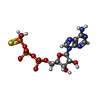+Search query
-Structure paper
| Title | Ratchet-like polypeptide translocation mechanism of the AAA+ disaggregase Hsp104. |
|---|---|
| Journal, issue, pages | Science, Vol. 357, Issue 6348, Page 273-279, Year 2017 |
| Publish date | Jul 21, 2017 |
 Authors Authors | Stephanie N Gates / Adam L Yokom / JiaBei Lin / Meredith E Jackrel / Alexandrea N Rizo / Nathan M Kendsersky / Courtney E Buell / Elizabeth A Sweeny / Korrie L Mack / Edward Chuang / Mariana P Torrente / Min Su / James Shorter / Daniel R Southworth /  |
| PubMed Abstract | Hsp100 polypeptide translocases are conserved members of the AAA+ family (adenosine triphosphatases associated with diverse cellular activities) that maintain proteostasis by unfolding aberrant and ...Hsp100 polypeptide translocases are conserved members of the AAA+ family (adenosine triphosphatases associated with diverse cellular activities) that maintain proteostasis by unfolding aberrant and toxic proteins for refolding or proteolytic degradation. The Hsp104 disaggregase from solubilizes stress-induced amorphous aggregates and amyloids. The structural basis for substrate recognition and translocation is unknown. Using a model substrate (casein), we report cryo-electron microscopy structures at near-atomic resolution of Hsp104 in different translocation states. Substrate interactions are mediated by conserved, pore-loop tyrosines that contact an 80-angstrom-long unfolded polypeptide along the axial channel. Two protomers undergo a ratchet-like conformational change that advances pore loop-substrate interactions by two amino acids. These changes are coupled to activation of specific nucleotide hydrolysis sites and, when transmitted around the hexamer, reveal a processive rotary translocation mechanism and substrate-responsive flexibility during Hsp104-catalyzed disaggregation. |
 External links External links |  Science / Science /  PubMed:28619716 / PubMed:28619716 /  PubMed Central PubMed Central |
| Methods | EM (single particle) |
| Resolution | 4.0 - 6.7 Å |
| Structure data | EMDB-8697, PDB-5vjh: EMDB-8744, PDB-5vy8: |
| Chemicals |  ChemComp-AGS:  ChemComp-ADP: |
| Source |
|
 Keywords Keywords | CHAPERONE / Hsp104 / cryoem / AAA+ |
 Movie
Movie Controller
Controller Structure viewers
Structure viewers About Yorodumi Papers
About Yorodumi Papers













